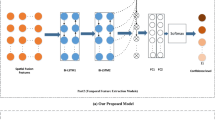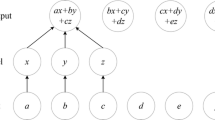Abstract
Automatic modulation recognition is a major project in the field of radio cognition; however, the generalization ability of conventional models cannot satisfy practical applications. In order to improve the generalization performance of the deep learning model and increase its recognition efficiency, we propose a novel model: ElsNet (elastic convolutional neural network). This network designs a channel optimization module, by inputting the average pooling information of the feature map and the intrinsic parameters of the batch normalization layer, to dynamically optimize the connection relations between network neurons and enhance the generalization ability of the model. ElsNet achieves an accuracy of about 94% at signal-to-noise ratios of 0-20 dB. Subsequent experiments have also demonstrated that, the ElsNet has a satisfying performance in transferred data sets and a peak accuracy of 82% through transfer learning, which to a certain extent alleviates the problem that the current signal modulation recognition can only be applied to signals with the same modulation parameters as the training dataset and has poor performance in recognizing real signals with different modulation parameters.















Similar content being viewed by others
References
Dobre OA, Abdi A, Bar-Ness YWS (2007) Survey of automatic modulation classification techniques: Classical approaches and new trends. IET Commun 1(2):137–156
Jeong S, Lee U, Kim SC (2018) Spectrogram-based automatic modulation recognition using convolutional neural network. In: 2018 tenth international conference on ubiquitous and future networks (ICUFN). IEEE, pp 843–845
Nandi AK, Azzouz EE (1998) Algorithms for automatic modulation recognition of communication signals. IEEE Trans Commun 46(4):431–436
Qi P, Zhou X, Zheng S, Li Z (2020) Automatic modulation classification based on deep residual networks with multimodal information. IEEE Trans Cognitive Commun Netw 7(1):21– 33
Zhang M, Zeng Y, Han Z, Gong Y (2018) Automatic modulation recognition using deep learning architectures. In: 2018 IEEE 19th international workshop on signal processing advances in wireless communications (SPAWC). IEEE, pp 1–5
Liu K, Gao W, Huang Q (2021) Automatic modulation recognition based on a dcn-bilstm network. Sensors 21(5):1577
Sun Y, Li J, Lin F, Pan G (2019) Automatic signal modulation recognition based on deep convolutional neural network. In: 3rd international conference on computer engineering, information science & application technology (ICCIA 2019). Atlantis Press, pp 550–554
Becker S, Plumbley M (1996) Unsupervised neural network learning procedures for feature extraction and classification. Appl Intell 6(3):185–203
Krizhevsky A, Sutskever I, Hinton GE (2017) Imagenet classification with deep convolutional neural networks. Commun ACM 60(6):84–90
Wang Y, Liu M, Yang J, Gui G (2019) Data-driven deep learning for automatic modulation recognition in cognitive radios. IEEE Trans Veh Technol 68(4):4074–4077
Huang S, Chai L, Li Z, Zhang D, Yao Y, Zhang Y, Feng Z (2019) Automatic modulation classification using compressive convolutional neural network. IEEE Access 7:79636– 79643
Zeng Y, Zhang M, Han F, Gong Y, Zhang J (2019) Spectrum analysis and convolutional neural network for automatic modulation recognition. IEEE Wireless Commun Lett 8(3):929–932
O’shea TJ, West N (2016) Radio machine learning dataset generation with gnu radio. In: Proceedings of the GNU Radio Conference, vol 1
Xu Y, Li D, Wang Z, Guo Q, Xiang W (2019) A deep learning method based on convolutional neural network for automatic modulation classification of wireless signals. Wirel Netw 25(7):3735–3746
Shin HC, Roth HR, Gao M, Le L, Xu Z, Nogues I, Yao J, Mollura D, Summers RM (2016) Deep convolutional neural networks for computer-aided detection: cnn architectures, dataset characteristics and transfer learning. IEEE Trans Med Imaging 35(5):1285–1298
Feng N, Wang F, Qiu Y (2006) Novel approach for promoting the generalization ability of neural networks. International Journal of Signal Processing 2(2)
Wang A, Zhang J, Jiang K, Wu H, Iwahori Y (2021) A new convolutional neural network is used to identify mpsk signal modulation methods. Journal of Harbin University of Science and Technology 26 (5):7
Simonyan K, Zisserman A (2014) Very deep convolutional networks for large-scale image recognition. arXiv:1409.1556
O’Shea TJ, Roy T, Clancy TC (2018) Over-the-air deep learning based radio signal classification. IEEE J Sel Top Signal Process 12(1):168–179
O’Shea TJ, Corgan J, Clancy TC (2016) Convolutional radio modulation recognition networks. In: International conference on engineering applications of neural networks. Springer, pp 213– 226
He K, Zhang X, Ren S, Sun J (2016) Deep residual learning for image recognition. In: Proceedings of the IEEE conference on computer vision and pattern recognition, pp 770–778
Xie S, Girshick R, Dollár P, Tu Z, He K (2017) Aggregated residual transformations for deep neural networks. In: Proceedings of the IEEE conference on computer vision and pattern recognition, pp 1492–1500
He J, Xu C, Yin C, Li P (2021) Modulation recognition of communication signals based on deep learning. In: 2021 IEEE 2nd international conference on information technology, big data and artificial intelligence (ICIBA), vol 2 IEEE, pp 527–531
Liu Z, Li J, Shen Z, Huang G, Yan S, Zhang C (2017) Learning efficient convolutional networks through network slimming. In: Proceedings of the IEEE international conference on computer vision, pp 2736–2744
Woo S, Park J, Lee J-Y, Kweon IS (2018) Cbam: convolutional block attention module. In: Proceedings of the European conference on computer vision (ECCV), pp 3–19
Adzhemov S, Tereshonok M, Chirov D (2015) Type recognition of the digital modulation of radio signals using neural networks. Mosc Univ Phys Bull 70(1):22–27
Jajoo G, Kumar Y, Yadav SK, Adhikari B, Kumar A (2017) Blind signal modulation recognition through clustering analysis of constellation signature. Expert Syst Appl 90:13–22
Weng L, He Y, Peng J, Zheng J, Li X (2021) Deep cascading network architecture for robust automatic modulation classification. Neurocomputing 455:308–324
Huynh-The T, Hua C-H, Pham Q-V, Kim D-S (2020) Mcnet: an efficient cnn architecture for robust automatic modulation classification. IEEE Commun Lett 24(4):811–815
Zou B, Zeng X, Wang F (2022) Research on modulation signal recognition based on cldnn network. Electronics 11(9):1379
Hu S, Pei Y, Liang PP, Liang Y-C (2019) Deep neural network for robust modulation classification under uncertain noise conditions. IEEE Trans Veh Technol 69(1):564–577
Rajendran S, Meert W, Giustiniano D, Lenders V, Pollin S (2018) Deep learning models for wireless signal classification with distributed low-cost spectrum sensors. IEEE Trans Cognitive Commun Netw 4(3):433–445
Lao S, Gong Y, Shi S, Yang S, Wu T, Wang J, Xia W, Yang Y (2022) Attentions help cnns see better: attention-based hybrid image quality assessment network. In: Proceedings of the IEEE/CVF conference on computer vision and pattern recognition, pp 1140–1149
O’Shea TJ, Pemula L, Batra D, Clancy TC (2016) Radio transformer networks: attention models for learning to synchronize in wireless systems. In: 2016 50th asilomar conference on signals, systems and computers. IEEE, pp 662–666
Chen Y (2021) Research on modulation signal recognition technology based on deep learning. PhD thesis, Nanchang University
Bu K, He Y, Jing X, Han J (2020) Adversarial transfer learning for deep learning based automatic modulation classification. IEEE Signal Process Lett 27:880–884
Chen G, Wang W, Wang Z, Liu H, Zang Z, Li W (2020) Two-dimensional discrete feature based spatial attention capsnet for semg signal recognition. Appl Intell 50(10):3503–3520
Zou B, Yan H, Wang F, Zhou Y, Zeng X (2022) Research on signal modulation classification under low snr based on resnext network. Electronics 11(17):2662
Li Z, Zhang Y (2020) Densenet-resnet-lstm model for modulation recognition of communication signal. In: Journal of physics: Conference series, vol 1693. IOP Publishing, p 012150
Perenda E, Rajendran S, Bovet G, Pollin S, Zheleva M (2021) Learning the unknown: Improving modulation classification performance in unseen scenarios. In: IEEE INFOCOM 2021-IEEE conference on computer communications. IEEE, pp 1–10
ZHANG T, FAN C, GE W, ZHANG T (2020) Mimo signal modulation recognition algorithm based on ica and feature extraction. J Electron Inform Technol 42(9):2208–2215
Meng F, Chen P, Wu L, Wang X (2018) Automatic modulation classification: a deep learning enabled approach. IEEE Trans Veh Technol 67(11):10760–10772
Acknowledgements
We would like to thank Michael Tan in University College London, the UK and Yuelian Liu for proofreading our work. This work is supported by the University-Enterprise Cooperation Projects (19H0355, 19H1121, 21H0959). We are also very grateful to Ms. Dong Xing for her help with proofreading.
Author information
Authors and Affiliations
Corresponding author
Ethics declarations
Conflict of Interests
The authors declare no conflict of interest.
Additional information
Publisher’s note
Springer Nature remains neutral with regard to jurisdictional claims in published maps and institutional affiliations.
Rights and permissions
Springer Nature or its licensor (e.g. a society or other partner) holds exclusive rights to this article under a publishing agreement with the author(s) or other rightsholder(s); author self-archiving of the accepted manuscript version of this article is solely governed by the terms of such publishing agreement and applicable law.
About this article
Cite this article
Wang, F., Zhou, Y., Yan, H. et al. Enhancing the generalization ability of deep learning model for radio signal modulation recognition. Appl Intell 53, 18758–18774 (2023). https://doi.org/10.1007/s10489-022-04374-7
Accepted:
Published:
Issue Date:
DOI: https://doi.org/10.1007/s10489-022-04374-7




